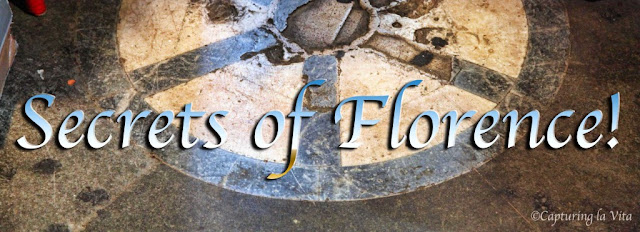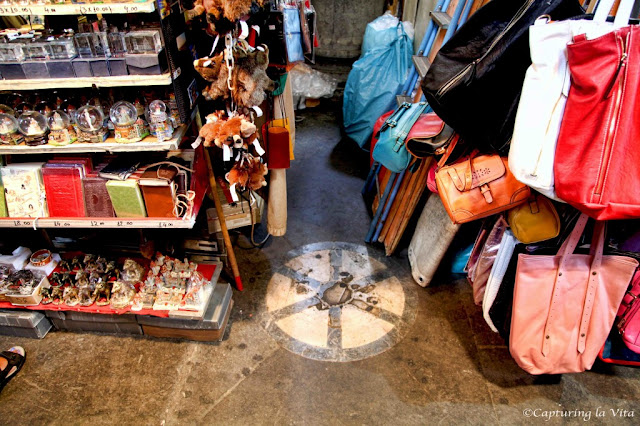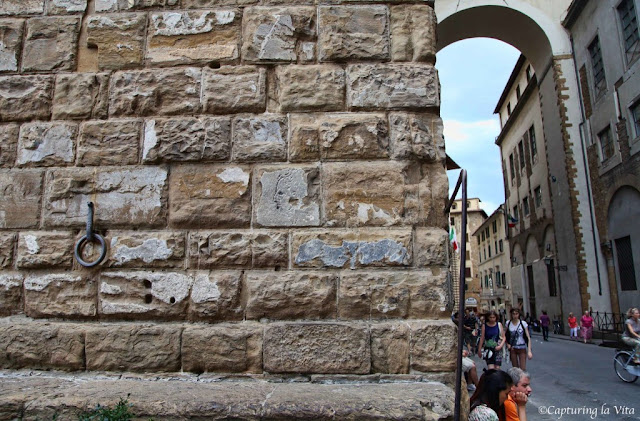Would you like to know more about Florence than many Florentines?
Allow me to share with you my second installation of The Secrets of Florence.

The first, Finding the Hidden Secrets of Florence: 8 You Don't Want to Miss, was so fun, I had to go hunting for more!
In Part Two, you will find that Michelangelo was a graffiti artist, Cellini a self-absorbed sculptor, and if you had debts in Renaissance Florence, you may have just ended up beaten and naked in the public square.
Florence is a city of history, of mystery, and of many secrets. Come along and I will let you in on a few. I love sharing these little historical gems of this remarkable city, but it’s even more fun when I get to point them out to an unexpecting tourist passing by! If you’re ever in Florence and see a blond Sherlock, kids in tow, that’s me, ferreting out the secrets of Florence.
Happy hunting!
Naked Debtors

In the center of floor in the 16th century Loggia del Mercato Nuovo (Porcellino), you will find this engraved wheel. That is, if you are persistent enough. It is not as easy to find as I thought, but I refused to give up on this one. I must have been searching the rows of market stalls for at least 20 minutes. I finally discovered it hidden behind one of the stalls, covered by utility items. I quietly took it upon myself to move things around a bit to get a better view.
The six-spoked marble wheel is located where the Florentine Carroccio once stood. The Carroccio, an ox-drawn war chariot and symbol of the Florentine Republic, was used as a gathering point for soldiers, and where priests would hold services before a battle.
Later during the Renaissance, the stone wheel was called pietra dell’acculata - “the stone of the bum punishment,” or pietra dello scandalo - the “stone of the shame.” It was used as spot for a debtor’s punishment. The insolvent merchant would be forced to remove their pants and undergarments and would be struck on the buttocks with a chain until he fell to the ground.
The popular Italian expression stare col culo a terra, “to have one’s ass on the ground,” most likely originated from this practice.
It is incongruous to think of the history of this place amidst the crazy jumble of merchandise available today. What would those merchants from so long ago think of the markets of today?

A Real Italian Time Traveler
Every day, thousands of people walk through the main doors of the Basilica of Santa Maria Novella. Little do they know that as they enter, they pass two astronomical instruments critical to the calendar we still use today.
These ancient astronomical instruments are located on either side of the main doors of the Basilica. Ignazio Danti, an astronomer, cartographer, and Dominican monk, placed the instruments on the facade of the church. He used them to study the movement of the sun and calculate the discrepancy between the solar year and Julius Caesar’s Julian calendar.
Under Cosimo Medici’s instruction, Danti needed to enact a definitive calendar reform that would eliminate the ten days’ delay with the spring equinox occurring in respect to the true astronomical equinox. The calculations Danti made were to correct the Julian calendar, which was used up until this time.
The new calendar, known as the Gregorian Calendar (after Pope Gregory XIII), established that October 4, 1582 would be immediately followed by October 15th. Danti subtracted ten days in the process and changed the occurrences of leap years – what a remarkable intellect to have figured this out!
This is how St. Theresa of Alvia died on the night between October 4 and October 15 in 1582.

Facing the facade, on the right, you see a quadrant with two sundials (1574) on the base.

On the left, you will find two equinoctial circles (1572). This armillary sphere is related to the astrolabe, which was used as a navigation tool for determining the position of the sun and stars.

Fashionable Frescos
In the late 13th century, the Arte della Lana (wool-makers guild), one of the seven great craft guilds of Florence, housed their merchants and workshops in what is now known as the Calimala shopping mall.
The frescos you see pictured below were painted in the 14th century, with some portraying actual wool production itself. You can still see these impressive works, in addition to the medieval architecture, juxtaposed against the modern fixtures of the current tenants, Murphy & Nye. The frescos continue to look out over a merchant space, keeping with the spirit of the original Arte della Lana market.

There are very few remaining depictions of wool production in Florence, which makes these frescos even more special. Look carefully at the walls - perhaps you will notice a few wool artists busy at work.
Murphy & Nye is located on Calimala, 16 red. While this shop and the others in the building will welcome you to see the art, please respect the space and refrain from using flash photography. Where else can you shop amidst real 13th century art?

Renaissance Graffiti
Even the masters put value in adding a bit of graffiti to the city. While the actual story is uncertain, we do know that the graffiti artist here was Michelangelo himself.
Do you see it?

One story goes that Michelangelo, when he used to cross Piazza della Signoria, was often stopped by an unpleasant acquaintance, who pressed him with long winded chats. Once, Michelangelo, who was unable to get rid of this man, leaned against the wall of the palace, feigning listening. He put his hands behind his back and chiseled the man’s profile as he listened to him rambling on. Another version states that he was chiseling the profile of a man that was being hung in the square. A far less likely story says that when Michelangelo was a kid, he was dared to do a carving with his hands tied behind his back. He then proceeded to carve out this face on the side of Palazzo Vecchio – using his mouth.
Whichever story you prefer, this is one of the most fun secrets in Florence!

The Many Faces of Cellini
In the open air museum of Piazza della Signoria, beneath the roof of the Loggia dei Lanzi, you will find the powerful Perseus by Benvenuto Cellini.
The statue of Perseus was meant to express the power of Grand Duke of Florence against the enemies of the city. Perseus represents the young Duke, who conquers the Republican monster, represented by Medusa.

Cellini was known to be a self-centered person. If you walk into the Loggia and view the statue from behind, you will see Cellini’s face looking down upon you from the back of Perseus’ head.
In his autobiography, Cellini wrote that a statue must be viewed from eight sides, with each side being of the same quality to the viewer. Perhaps he was ensuring that we all got a glimpse of his carefully sculpted self-portrait.

The Wine Holes
Throughout the city of Florence, you will notice small doors located within walls. Many have since been sealed, but you can still see some of them in their original form. These wine portals, called buchette del vino, are unique to Florence.
The aristocratic families of Florence owned large areas of land and vineyards outside the city and produced much of wine for Florence. The owners of the wine needed a way to sell their wine while keeping the less desirable consumers out of their cantinas, so excess wine was sold to the public through these portals.
The small opening, the size of a fiasco of wine, was just the right size. When a knock was heard at the door, the cantiniere (a bartender of sorts) dispensed wine into the awaiting cup or bottle. The hole was just large enough to pass through a straw-covered fiasco (liter) of wine from the customer (and a filled fiasco back to him, upon payment).
More generous cantiniere, after closing, would leave out a cup of wine and bread for the destitute.
Below, you see one of the best examples of these wine holes, at the buchetta of Palazzo Viviani. The marble plaque notes the sales hours “from November 1 until all of April from 9 a.m. until 2 p.m. and from 5 till 8 p.m and the first of May through all of October…”

Explore a Corridor Museum
While you already have visiting the Uffizi Gallery on your list (get your tickets at www.ticketsflorence.com to avoid the lines), did you know that there's a small museum attached to the Uffizi? The Vasari Corridor is one of the hidden treasures of the city, because access to the Corridor is difficult to obtain. This kilometer-long passageway that connects the Uffizi Gallery and the Pitti Palace, crossing the river at Ponte Vecchio, is remarkable. It's an art gallery, offers a glimpse into the Church of Santa Felicita, and provides a new aspect of the city's history. Currently undergoing renovations, it will reopen in 2018.
I wish you a wonderful journey as you explore the streets of this wonderful and historic city. You will find that the reward is not only in the treasures you discover, but in the journey you take to find them.
Don’t forget to see my original secrets of Florence post, Finding the Hidden Secrets of Florence: 8 You Don't Want to Miss.
Do you know any more secrets in Florence? I invite you to share them with us in the comments below. I’d love to research them and share in a future Secrets of Florence post!
Laurel Perry is an Italy Expert. She shares her passion, tips, and Italy secrets with travelers through her work as a Family Travel Consultant, Italy and Luxury Travel Specialist with Ciao Bambino.
All photos courtesy and copyright Laurel Perry
